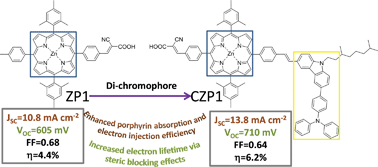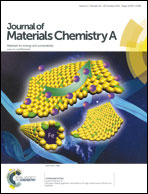Enhanced performance of dye-sensitized solar cells using carbazole-substituted di-chromophoric porphyrin dyes†
Abstract
The purpose of this work is to investigate the origin of improved photovoltaic performance of a series of di-chromophoric carbazole-substituted porphyrin dyes employed as sensitizers in dye-sensitized solar cells. Five di-chromophoric zinc porphyrin dyes with the same porphyrin core, a carbazole unit attached in the meso-position through a phenylethenyl linkage, and substituents spanning a range of electron affinities, in an attempt to tune the electronic level of the carbazole unit, have been synthesized (CZPs). Density functional theory (DFT) calculations predicted the nature of the electronic transitions observed in the CZP systems, showing a large degree of orbital mixing. In contrast, UV-vis absorption, resonance Raman spectroscopy and differential pulse voltammetry investigations suggested negligible interaction between the porphyrin and carbazole chromophores. Carbazole substitution led to a moderate increase in photon absorption intensity within the ∼300 nm to 400 nm wavelength region, a smaller but broader Soret band absorption and slightly increased photon absorption intensity in the 550 nm to 650 nm Q band region. Despite the rather small changes in light harvesting and negligible changes in the HOMO/LUMO electronic levels, the photovoltaic performance of the new dyes is increased by as much as 30% compared to the single chromophore Zn porphyrin dye 5-(4-(2-cyano-2-carboxyethenyl)phenyl-15-phenyl-10,20-bis(2,4,6-trimethylphenyl)porphyrinato zinc(II) (ZP1), leading to over 6% power conversion efficiencies (PCEs). Both open circuit voltage (VOC) and short circuit current (JSC) have increased. The increased VOC is attributed to increased electron lifetimes due to a steric blocking effect. Analysis of the increased short circuit current (ΔJSC) showed that only less than 10% of ΔJSC originates from increased light absorption under simulated air mass 1.5 illumination, while the rest of the improvements are attributed to a steric effect enhancing the electron injection efficiency. These results suggest that developing non-conjugated multichromophoric dyes can lead to simultaneous increases in both the photocurrent and the photovoltage of dye-sensitized solar cells.


 Please wait while we load your content...
Please wait while we load your content...